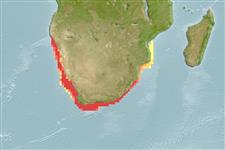Environment: milieu / climate zone / Tiefenbereich / distribution range
Ökologie
seewasser demersal; tiefenbereich 10 - 390 m (Ref. 4316). Subtropical; 18°S - 36°S, 12°E - 36°E
Southeast Atlantic and Western Indian Ocean: Cape Fria, Namibia to Maputo, Mozambique. The record of a specimen from Reunion (MHNRUN 36) is probably erroneous (Ref. 33390).
Length at first maturity / Size / Gewicht / Alter
Geschlechtsreife: Lm 32.8, range 27 - 35 cm
Max length : 75.0 cm TL Männchen/unbestimmt; (Ref. 3699); common length : 35.0 cm TL Männchen/unbestimmt; (Ref. 3699); max. veröff. Alter: 16 Jahre (Ref. 26321)
Kurzbeschreibung
Bestimmungsschlüssel | Morphologie | Morphometrie
Rückenflossenstacheln (insgesamt) : 8 - 9; Rückenflossenweichstrahlen (insgesamt) : 15 - 17; Afterflossenstacheln: 0; Afterflossenweichstrahlen: 14 - 16.
Body shape (shape guide): fusiform / normal.
Found over sandy and muddy bottoms in coastal areas. Feeds on fishes (Ref. 4316) and crustaceans (Ref. 5213). Excellent food fish (Ref. 4316).
Life cycle and mating behavior
Geschlechtsreife | Fortpflanzung | Ablaichen | Eier | Fecundity | Larven
Richards, W.J. and V.P. Saksena, 1990. Triglidae. p. 680-684. In J.C. Quero, J.C. Hureau, C. Karrer, A. Post and L. Saldanha (eds.) Check-list of the fishes of the eastern tropical Atlantic (CLOFETA). JNICT, Lisbon; SEI, Paris; and UNESCO, Paris. Vol. 2. (Ref. 3687)
IUCN Rote Liste Status (Ref. 130435: Version 2024-2)
Bedrohung für Menschen
Harmless
Nutzung durch Menschen
Fischereien: kommerziell
Tools
Zusatzinformationen
Download XML
Internet Quellen
Estimates based on models
Preferred temperature (Ref.
123201): 10.3 - 17.9, mean 13.3 °C (based on 65 cells).
Phylogenetic diversity index (Ref.
82804): PD
50 = 0.5010 [Uniqueness, from 0.5 = low to 2.0 = high].
Bayesian length-weight: a=0.00912 (0.00427 - 0.01947), b=3.05 (2.87 - 3.23), in cm total length, based on LWR estimates for this (Sub)family-body shape (Ref.
93245).
Trophic level (Ref.
69278): 4.1 ±0.3 se; based on diet studies.
Widerstandsfähigkeit (Ref.
120179): niedrig, Verdopplung der Population dauert 4,5 - 14 Jahre. (K=0.14; tm=2-5; tmax=12).
Fishing Vulnerability (Ref.
59153): High to very high vulnerability (65 of 100).
🛈
Climate Vulnerability (Ref.
125649): Moderate to high vulnerability (48 of 100).
🛈
Nutrients (Ref.
124155): Calcium = 48.1 [26.1, 116.6] mg/100g; Iron = 0.887 [0.473, 1.884] mg/100g; Protein = 19.4 [18.1, 20.7] %; Omega3 = 0.547 [0.256, 1.473] g/100g; Selenium = 41.8 [20.1, 112.1] μg/100g; VitaminA = 12.2 [4.1, 36.7] μg/100g; Zinc = 0.608 [0.429, 0.899] mg/100g (wet weight);
